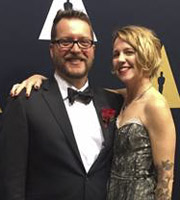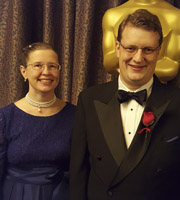Barratt was part of a quartet honored with a Scientific and Engineering Award for an innovative motion control and capture system. Wedig and a colleague were honored with a Technical Achievement Award for a facial performance-capture system. Their innovations have been used in scores of high-profile, visual-effects heavy films, including “The Life of Pi,” “Avatar,” and “The Curious Case of Benjamin Button.” And both credit their time studying computer science at UCLA as critical to their careers.
Barratt and Wedig were among 34 individuals and five organizations (pictured above) honored this year at the academy’s Scientific and Technical Awards, hosted by actors Leslie Mann and John Cho.
Click here to read more about Barratt and Wedig

Joshua Barratt ’01
In the mid-2000s, Joshua Barratt was in his first programming job out of college, and looking to move from the Central Coast to Los Angeles. A friend who worked at the Jim Henson Company suggested he connect with a former colleague who just left to start his own company called Concept Overdrive, which aimed to create a better system to synthesize live performance, special effects and increasingly powerful and more realistic computer graphics.
They needed a software engineer. Barratt, who majored in computer science and engineering at UCLA, found out about the opportunity on a Wednesday, interviewed on Thursday and started working the very next Monday.
The work involved helping develop the company’s complex motion control system – which integrates actors and mechanical props on the set with computer graphics. The system works with all different kinds of inputs –camera lenses, joysticks that operate props, and the motions of puppeteers to combine with computer graphics that accompany the scene. It can take in all that data, and then output it to other parts of the system. For example, it rocks a spaceship back and forth in accordance with what’s happening outside the ship with CGI effects.
“It’s kind of like duct tape for modern movie making,” Barratt said.
The system got its big break during the making of “The Last Samurai” a 2003 film starring Tom Cruise as a Civil War veteran caught up in a conflict in 19th century Japan. The filmmakers wanted tight shots of Cruise during epic battle scenes as he’s riding a horse. The system helped recreate the battlefield intensity by moving the mechanical horse that Cruise was riding, as it reacted to the prerecorded motion of other horses and riders.
Since then the system has been used in dozens of big special effects films, including the “Iron Man” series; “The Hobbit” series; “Avatar;” “The Life of Pi;” “The Martian;” “Disney’s Pete’s Dragon” and “Rogue One: A Star Wars Story.”
A decade-and-a-half later, Barratt is one of four early Concept Drive employees that received a Scientific and Engineering Award from the Academy of Motion Picture Arts and Sciences. Honored with Barratt are company founder Steven Rosenbluth, and Robert Nolty and Archie Te. The award was given “for the engineering and development of the Concept Overdrive motion control system.”
Barratt credits his time at UCLA Engineering as critical to his career success.
“From an education standpoint, I think a lot of classes were fantastic and directly applicable – networking, regular languages, compilers, operating systems – all of those I directly leveraged when working on this project and ever since,” Barratt said.
“Technology comes and goes, but the principles are pretty permanent,” he said of his major’s curriculum. “I found the most lasting stuff was from the theory-based classes that also had some hands-on components, because it made the ideas really stick.”
Today Barratt is the Chief Architect at Media Temple, a premium web hosting and cloud services company with 1.5 million sites for more than 125,000 customers around the world.

Geoff Wedig MS ’95
Geoff Wedig was always a programmer. He got his start coding as a kid in the early 1980s, creating animated Christmas cards and video games on a Texas Instruments TI 99/4A. About as powerful as a VCR, he recalled.
He majored in mathematics and creative writing at Case Western Reserve University in his native Ohio. Then he came to UCLA to pursue graduate study in computer science, picking the department for its strengths in artificial intelligence and computer graphics.
One class in particular that stood out for him was an algorithms class. “It tempered a lot of how I think about approaching these problems,” he said of how it applied to his virtual reality work. “Each problem is kind of unique and crazy.”
Following his master’s degree, he decided to work for a little while deciding if he should pursue a doctorate. He returned to Case Western Reserve, this time writing scientific programs analyzing genetic data for epidemiological research. He ended up spending 12 years there.
But the idea of computer graphics still tugged at him. So in the mid-2000s and in his spare time, he worked on a trailer as part of his demo reel, which he titled “Invasion from Beyond the Galaxy.” Sending that reel out to visual effects firms got him a few interviews and he finally landed a job at Digital Domain, which was based in Venice, Calif. at the time.
The company had a project to virtually age Brad Pitt by decades in 2008’s “The Curious Case of Benjamin Button.” This became the start of the new facial performance capture system that was recognized by the academy this year. The real Brad Pitt never actually appears in the film until 45 minutes in. The technology was refined in a subsequent film, this time to make an older Jeff Bridges appear much younger in 2010’s “Tron: Legacy.” The technology has since been used in many films and other projects. For example, for the character Colossus, a metallic strongman superhero, in 2016’s “Deadpool.” And in 2012, Wedig and colleagues worked in secret for just a few weeks to create a hologram of the late Tupac Shakur, which was used in a memorable performance on stage with Snoop Dogg at 2012 Coachella music festival.
As for getting in the industry, Wedig suggested those with technical backgrounds might have a better shot than they think.
“There’s a lot of people who do math and science and want to get into visual effects but don’t feel they’re artists,” he said. “However, very technical people can be wonderful for this kind of thing.”
The academy recognized Wedig, along with co-recipient Nicholas Apostoloff who had been working on similar technology independent of him, “for the design and development of animation rig-based facial performance-capture systems at ImageMovers Digital and Digital Domain.”
Wedig worked at Digital Domain until two years ago. Today he is a programming lead at Magic Leap, a startup looking to develop new computing platforms that will combine the physical and virtual worlds.
Main image: Group photo of the 2017 Scientific & Technical Award winners. Academy of Motion Picture Arts and Sciences
